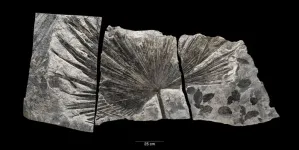(Press-News.org) All living organisms emit a low level of light radiation, but the origin and function of these 'biophotons' are not yet fully understood. An international team of physicists, funded by the Foundational Questions Institute, FQxI, has proposed a new approach for investigating this phenomenon based on statistical analyses of this emission. Their aim is to test whether biophotons can play a role in the transport of information within and between living organisms, and whether monitoring biophotons could contribute to the development of medical techniques for the early diagnosis of various diseases. Their analyses of the measurements of the faint glow emitted by lentil seeds support models for the emergence of a kind of plant ‘intelligence,’ in which the biophotonic emission carries information and may thus be used by plants as a means to communicate. The team reported this and reviewed the history of biophotons in an article in the journal Applied Sciences in June 2024.
Around a century ago, Russian biologist Alexander Gurwitsch realized that onions give off a weak electromagnetic field, related to cell growth. “Since then, scientists have found that bacteria, plants, animals and even humans emit biophotons,” says Catalina Curceanu, a member of FQxI and an experimental nuclear and quantum physicist at the National Institute for Nuclear Physics (INFN), in Frascati, Italy.
“Some scientists think that these biophotons might be involved in the exchange of information, but so far no single model has been able to explain where they come from and what they are for,” adds Maurizio Benfatto, also at INFN, who led the data analyses.
“Some scientists think that these biophotons might be involved in the exchange of information,” says Benfatto. “People even release more biophotons when they are angry.”
Over the years, scientists have tried to monitor biophoton emission from germinating seeds as a way of measuring their quality and to study the effects of pesticides and fertilizers on plants, and also as a means for checking on food quality. Experiments with tissue slices have even shown different biophoton emission rates between tumor cells and non-malignant cells. “People even release more biophotons when they are angry,” says Benfatto.
One difficulty with performing definitive experiments is that the biophoton signal is very weak and easily drowned out by surrounding lights and noise. Curceanu and her colleagues measured biophotons emanating from 76 lentil seeds in a germination chamber, housed in a darkened box, using a highly sensitive quantum photon detector.
Emerging Plant Intelligence
The team monitored the seeds over time windows that ranged from 10 to 60 hours. The pattern of emissions supports the notion that biophoton release is related to the activation of different cell groups, during the germination process. “Each unit can be thought of as a node in a network,” explains Benfatto, “and each node interacts with neighboring nodes before emitting biophotons.” This can be interpreted as the emergence of “co-operation and intelligence” he says, in that the units are sensitive to their nearest neighbors and also to units very far away. This global intelligence helps to determine whether releasing biophotons would increase or decrease global benefit for the plant.
The work was partially funded by the Foundational Questions Institute, FQxI, which aims to catalyze research into fundamental science. “Understanding this phenomenon not only sheds new light on the mechanisms used in living matter but also opens the possibility for new ideas in the treatment of human and non-human pathologies,” says Curceanu. “I am grateful that FQxI gave us the opportunity to uncover potential links between biophotons and a form of plant intelligence.”
“Understanding this phenomenon not only sheds new light on the mechanisms used in living matter but also opens the possibility for new ideas in the treatment of human and non-human pathologies,” says Curceanu.
Curceanu notes that more work is needed to uncover, for instance, where biophotons originate—possibly within mitochondria—and to confirm whether they carry information. If so, “what kind of information?” Curceanu asks. “And can we somehow change the information they carry?”
Sensitive Signals
Curceanu, Benfatto and colleagues have also outlined economical ways in which future experiments could be improved to pick up these sensitive signals. This includes using a ‘Fresnel lens’ (a sectioned convex lens with vertical parallel planes forming concentric rings) to potentially improve the number of light photons collected by a factor of more than 10. The team also suggests housing the seeds within a white Teflon sphere, to improve light reflection. “Teflon reflects more than 99% of light, so biophotons will bounce around the sphere before eventually hitting the detector,” says Benfatto.
“We have also included other improvements in our paper which we hope will also inspire others to investigate this fascinating natural phenomenon,” says Curceanu.
This work was partially supported through an FQxI Fulcrum grant and through FQxI's Consciousness in the Physical World program. You can read more about the team’s grants in the FQxI article: “Can We Feel What It's Like to Be Quantum?” by Brendan Foster.
Journal reference, Applied Sciences: Appl. Sci 2024, 14(13), 5496; https://doi.org/10.3390/app14135496
END
Shining a light on the roots of plant “intelligence”
Statistical analyses of biophotons from lentil seeds support models for the emergence of a kind of plant ‘intelligence’
2024-09-19
ELSE PRESS RELEASES FROM THIS DATE:
Scientists identify a unique combination of bacterial strains that could treat antibiotic-resistant gut infections
2024-09-19
Antibiotic-resistant bacterial infections often occur in patients with chronic inflammatory intestinal conditions, such as inflammatory bowel disease, and in patients who have taken antibiotics for a long time. Gram-negative bacteria such as Enterobacteriaceae are a common cause of these infections and have few treatment options. Fecal microbiota transplants have shown promise to curb some of these infections, but their composition varies between batches and they aren’t always successful.
Researchers at Keio University School of Medicine in Tokyo and the Broad Institute of MIT and Harvard have isolated ...
Pushing kidney-stone fragments reduces stones’ recurrence
2024-09-19
Sometimes all it takes is a little push.
That is the conclusion of a recently published study in which doctors used a handheld ultrasound device to nudge patients’ kidney-stone fragments.
As many as 50% of patients who have kidney stones removed surgically still have small fragments remaining in the kidneys afterward. Of those patients, about 25% find themselves returning for another operation within five years to remove the now-larger fragments.
UW Medicine researchers found, however, that patients ...
Sweet success: genomic insights into the wax apple's flavor and fertility
2024-09-19
A recent study has successfully decoded the autotetraploid genome of the wax apple, uncovering its genetic evolution and key factors driving fruit diversity. The research highlights the fruit’s rich antioxidant profile, with promising implications for human health and breeding strategies aimed at enhancing nutritional value.
Wax apple (Syzygium samarangense), known for its crisp texture, rose-like aroma, and health benefits, faces breeding challenges due to its complex genetic diversity and limited genomic data. These obstacles have hindered efforts to improve key fruit qualities such as size and sugar ...
New study charts how Earth’s global temperature has drastically changed over the past 485 million years, driven by carbon dioxide
2024-09-19
A new study co-led by the Smithsonian and the University of Arizona offers the most detailed glimpse yet of how Earth’s surface temperature has changed over the past 485 million years. In a paper published today, Sept. 19, in the journal Science, a team of researchers, including paleobiologists Scott Wing and Brian Huber from the Smithsonian’s National Museum of Natural History, produce a curve of global mean surface temperature (GMST) across deep time—the Earth’s ancient past stretching over many millions of years. ...
Scientists say we have enough evidence to agree global action on microplastics
2024-09-19
Science has provided more than sufficient evidence to inform a collective and global approach to tackle the continued spread of plastic pollution, according to a new report.
Writing in the journal Science, an international group of experts say the need for worldwide action to tackle all forms of plastic and microplastic debris has never been more pressing.
It is clear that existing national legislation alone is insufficient to address the challenge, they say, and the United Nations’ Plastic Pollution Treaty ...
485 million-year temperature record of Earth reveals Phanerozoic climate variability
2024-09-19
Estimating past global temperature is important for understanding the history of life on Earth and for predicting future climate. Now, a new reconstruction of Earth’s temperature history over the past 485 million years – based on a method that combines diverse physical proxy data with climate model predictions – reveals a much wider range of climate variability across the Phanerozoic eon than previously understood. The findings highlight atmospheric carbon dioxide (CO2) as the dominant factor controlling climate variability throughout this period, offering new ...
Atmospheric blocking slows ocean-driven glacier melt in Greenland
2024-09-19
Cooling in the subsurface waters beneath Greenland’s Nioghalvfjerdsfjorden Glacier (79NG) from 2018 to 2021 was driven by European atmospheric blocking, which forced changes in the large-scale ocean circulation of the Nordic seas, researchers report, slowing glacial melt, despite ongoing global warming trends. The findings highlight the importance of regional atmospheric dynamics in influencing glacier stability. Understanding these dynamics is key to predicting the future of glaciers like ...
Study: Over nearly half a billion years, Earth’s global temperature has changed drastically, driven by carbon dioxide
2024-09-19
Published in the journal Science, the study presents a curve of global mean surface temperature that reveals Earth's temperature has varied more than previously thought over much of the Phanerozoic Eon a period of geologic time when life diversified, populated land and endured multiple mass extinctions. The curve also confirms Earth's temperature is strongly correlated to the amount of carbon dioxide in the atmosphere.
The start of the Phanerozoic Eon 540 million years ago is marked by the Cambrian ...
Clinical trial could move the needle in traumatic brain injury
2024-09-19
FOR IMMEDIATE RELEASE
Subscribe to UCSF News
Department of Defense-funded study aims to end a decades-long impasse in treatment development.
Traumatic brain injury (TBI) results in close to 70,000 deaths in the United States every year, and it is the cause of long-term physical, cognitive and mental disability in 5 million Americans. But despite three decades of work, treatments are sorely lacking.
Now, an innovative drug development trial will be available in emergency departments of 18 level 1 trauma sites nationwide. It is launched by UC San Francisco and the Transforming Research and Clinical Knowledge in Traumatic ...
AI model can reveal the structures of crystalline materials
2024-09-19
For more than 100 years, scientists have been using X-ray crystallography to determine the structure of crystalline materials such as metals, rocks, and ceramics.
This technique works best when the crystal is intact, but in many cases, scientists have only a powdered version of the material, which contains random fragments of the crystal. This makes it more challenging to piece together the overall structure.
MIT chemists have now come up with a new generative AI model that can make it much easier to determine the structures of these powdered crystals. The prediction model could help researchers characterize ...
LAST 30 PRESS RELEASES:
Interaction of climate change and human activity and its impact on plant diversity in Qinghai-Tibet plateau
From addressing uncertainty to national strategy: an interpretation of Professor Lim Siong Guan’s views
Clinical trials on AI language model use in digestive healthcare
Scientists improve robotic visual–inertial trajectory localization accuracy using cross-modal interaction and selection techniques
Correlation between cancer cachexia and immune-related adverse events in HCC
Human adipose tissue: a new source for functional organoids
Metro lines double as freight highways during off-peak hours, Beijing study shows
Biomedical functions and applications of nanomaterials in tumor diagnosis and treatment: perspectives from ophthalmic oncology
3D imaging unveils how passivation improves perovskite solar cell performance
Enriching framework Al sites in 8-membered rings of Cu-SSZ-39 zeolite to enhance low-temperature ammonia selective catalytic reduction performance
AI-powered RNA drug development: a new frontier in therapeutics
Decoupling the HOR enhancement on PtRu: Dynamically matching interfacial water to reaction coordinates
Sulfur isn’t poisonous when it synergistically acts with phosphine in olefins hydroformylation
URI researchers uncover molecular mechanisms behind speciation in corals
Chitin based carbon aerogel offers a cleaner way to store thermal energy
Tracing hidden sources of nitrate pollution in rapidly changing rural urban landscapes
Viruses on plastic pollution may quietly accelerate the spread of antibiotic resistance
Three UH Rainbow Babies & Children’s faculty elected to prestigious American Pediatric Society
Tunnel resilience models unveiled to aid post-earthquake recovery
Satellite communication systems: the future of 5G/6G connectivity
Space computing power networks: a new frontier for satellite technologies
Experiments advance potential of protein that makes hydrogen sulfide as a therapeutic target for Alzheimer’s disease
Examining private equity’s role in fertility care
Current Molecular Pharmacology achieves a landmark: real-time CiteScore advances to 7.2
Skeletal muscle epigenetic clocks developed using postmortem tissue from an Asian population
Estimating unemployment rates with social media data
Climate policies can backfire by eroding “green” values, study finds
Too much screen time too soon? A*STAR study links infant screen exposure to brain changes and teen anxiety
Global psychiatry mourns Professor Dan Stein, visionary who transformed mental health science across Africa and beyond
KIST develops eco-friendly palladium recovery technology to safeguard resource security
[Press-News.org] Shining a light on the roots of plant “intelligence”Statistical analyses of biophotons from lentil seeds support models for the emergence of a kind of plant ‘intelligence’



